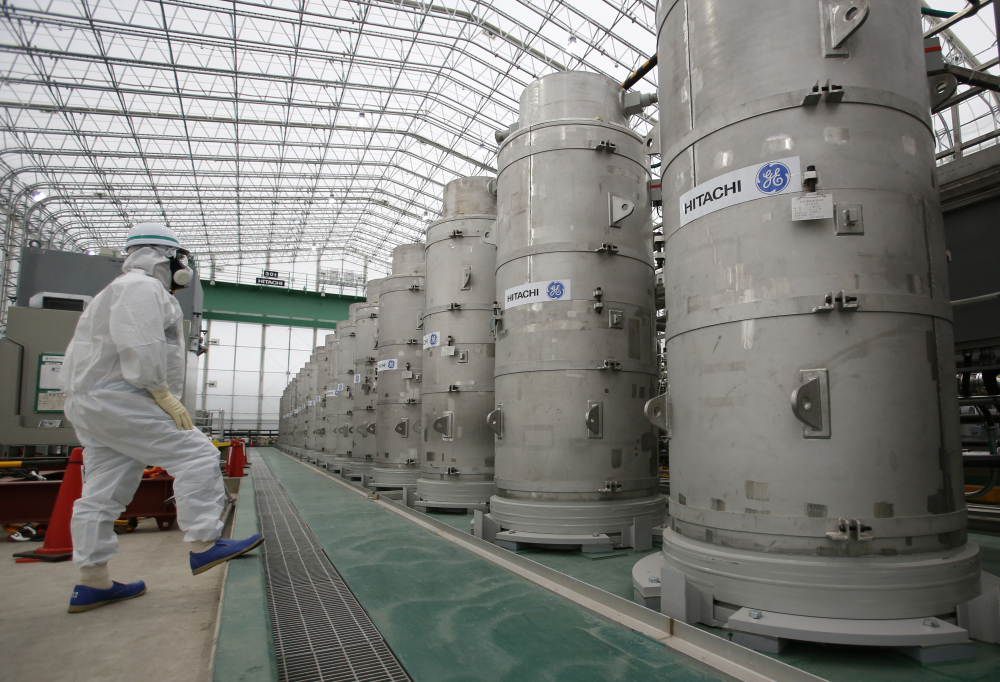TOKYO — More than three years into the massive cleanup of Japan’s tsunami-damaged nuclear power plant, only a tiny fraction of the workers are focused on key tasks such as preparing for the dismantling of the broken reactors and removing radioactive fuel rods.
Instead, nearly all the workers at the Fukushima Dai-ichi plant are devoted to an enormously distracting problem: a still-growing amount of contaminated water used to keep the damaged reactors from overheating. The amount has been swelled further by groundwater entering the reactor buildings.
Hundreds of huge blue and gray tanks to store the radioactive water and buildings holding water treatment equipment are rapidly taking over the plant, where the cores of three reactors melted following a 2011 earthquake and tsunami. Workers were building more tanks during a visit to the complex Wednesday by foreign media.
“The contaminated water is a most pressing issue that we must tackle. There is no doubt about that,” said Akira Ono, head of the plant. “Our effort to mitigate the problem is at its peak now. Though I cannot say exactly when, I hope things start getting better when the measures start taking effect.”
Every day, about 6,000 workers pass through the guarded gate of the Fukushima Dai-ichi plant on the Pacific coast – two to three times more than when it was actually producing electricity.
On a recent work day, about 100 workers were dismantling a makeshift roof over one of the reactor buildings, and about a dozen others were removing fuel rods from a cooling pool. Most of the rest were dealing with the contaminated water, said Tatsuhiro Yamagishi, a spokesman for Tokyo Electric Power Company, or TEPCO, the utility that owns the plant.
The work threatens to exhaust the supply of workers for other tasks, since employees must stop working when they reach annual radiation exposure limits. Experts say it is crucial to reduce the amount and radioactivity of the contaminated water to decrease the risk of exposure to workers and the environmental impact before the decommissioning work gets closer to the highly contaminated core areas.
The plant has six reactors, three of which were off-line when disaster struck on March 11, 2011. A magnitude-9.0 earthquake triggered a huge tsunami which swept into the plant and knocked out its backup power and cooling systems, leading to meltdowns at the three active reactors.
Decommissioning and dismantling all six reactors is a delicate, time-consuming process that includes removing the melted fuel from a highly radioactive environment, as well as all the extra fuel rods, which sit in cooling pools at the top of the reactor buildings. Workers must determine the exact condition of the melted fuel debris and develop remote-controlled and radiation-resistant robotics to deal with it. The process is expected to take at least 40 years.
The flow of underground water is doubling the amount of contaminated water and spreading it to vast areas of the compound.
The plant reuses some of the contaminated water for cooling after partially treating it, but the additional groundwater creates a huge excess that must be pumped out. Currently, more than 500,000 tons of radioactive water is being stored in nearly 1,000 large tanks.
Copy the Story LinkSend questions/comments to the editors.



Success. Please wait for the page to reload. If the page does not reload within 5 seconds, please refresh the page.
Enter your email and password to access comments.
Hi, to comment on stories you must . This profile is in addition to your subscription and website login.
Already have a commenting profile? .
Invalid username/password.
Please check your email to confirm and complete your registration.
Only subscribers are eligible to post comments. Please subscribe or login first for digital access. Here’s why.
Use the form below to reset your password. When you've submitted your account email, we will send an email with a reset code.